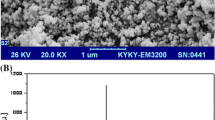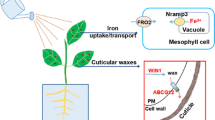Abstract
The effects of repeated foliar spray of nano and bulk iron oxide (α-Fe2O3) were physiologically investigated at four levels (0, 0.1, 0.25, and 0.5 g L–1) with and without citrate interaction on iron deficiency and excess stress during plant growth in pot conditions. There were no significant differences between nano and Balk treatments in terms of growth changes, iron absorption, and the possibility of transferring to the roots. But there were significant differences in terms of the antioxidant capacity variations, citrate detoxification effects, and the amounts of toxicity at high levels. Iron oxide increased total iron, active iron, chlorophyll, biomass, and antioxidants; at high levels, growth was reduced especially in nano. At all levels citrate made differences, so that at level 0.1 g L–1 like a nutritional operator increased biomass, chlorophyll and antioxidants. At 0.25 g L–1, there was antioxidant activity burst and chlorophylls increased; however, it reduced growth to similar conditions without citrate. At 0.5 g L–1, it decreased toxicity and iron availability but increased growth and antioxidants; these effects were more significant in nano. It seems that in nano treatments; enzymatic antioxidants, flavonoids, and phenolic compounds, and in the bulk; proline, carotenoids, and peroxidase enzymes were effective in the maximum decrease in oxidants. Confirming the importance of inducing an efficient antioxidant system in response to environmental stresses, here growth improvement of plants grown in iron-poor soils with iron oxide, and the healing effects of interacting with citrate in toxic conditions, at least in some cases, were related to the increase in antioxidant capacity and its vital role in the redox balance and stability of iron homeostasis.







Similar content being viewed by others
REFERENCES
Li, J., Chang, P.R., **, H., Wang, Y., Yuan, H., and Ren, H., Physiological effects of magnetic iron oxide nanoparticles towards watermelon, J. Nanosci. Nanotechnol., 2013, vol. 13, p. 5561. https://doi.org/10.1166/jnn.2013.7533
Schmidt, W., Thomine, S., and Buckhout, T.J., Iron nutrition and interactions in plants, Front. Plant Sci., 2020, vol. 10, p. 1670. https://doi.org/10.3389/fpls.2019.01670
Rui, M., Ma, C., Hao, Y., Guo, J., Rui, Y., Tang, X., Zhao, Q., Fan, X., Zhang, Z., Hou, T., and Zhu, S., Iron oxide nanoparticles as a potential iron fertilizer for peanut (Arachis hypogaea), Front. Plant Sci., 2016, vol. 7, p. 815. https://doi.org/10.3389/fpls.2016.00815
Alidoust, D. and Isoda, A., Effect of γFe2O3 nanoparticle on the photosynthetic characteristic of soybean (Glycine max (L.) Merr.): Foliar spray versus soil amendment, Acta Physiol. Plant., 2013, vol. 35, p. 3365. https://doi.org/10.1007/s11738-013-1369-8
Guo, L., Liu, Y., Luo, L., Hussain, S.B., Bai, Y., and Alam, S.M., Comparative metabolites and citrate-degrading enzyme activities in citrus fruits reveal the role of balance between ACL and Cyt-ACO in metabolite conversions, Plants, 2020, vol. 9, p. 350. https://doi.org/10.3390/plants9030350
Asadi-Kavan, Zh., Khavari-Nejad, R.A., Iranbakhsh, A., and Najafi, F., Cooperative effects of iron oxide nanoparticle (α-Fe2O3) and citrate on germination and oxidative system of evening primrose (Oenothera biennis L.), J Plant Interact., 2020, vol. 15, p. 166. https://doi.org/10.1080/17429145.2020.1774671
Greiner, S. and Köhl, K., Growing evening primroses (Oenothera), Front. Plant Sci., 2014, vol. 5, p. 38. https://doi.org/10.3389/fpls.2014.00038
Hwang, S.S., Park, J.S., and Namkoong, W., Ultrasonic-assisted extraction to release heavy metals from contaminated soil, J. Ind. Eng. Chem., 2007, vol. 13, p. 650.
Pandey, S.K. and Singh, H., A simple, cost-effective method for leaf area estimation, J. Bot., 2011, vol. 2011, p. 1. https://doi.org/10.1155/2011/658240
Singh, M. and Singh, S., Net assimilation rate, relative growth rate, and yield of pea genotypes under different NaHCO3 concentrations, Biol. Plant., 1994, vol. 36, p. 145. https://doi.org/10.1007/BF02921282
Raskar, S.V. and Laware, S.L., Effect of zinc oxide nanoparticles on cytology and seed germination in onion, Int. J. Curr. Microbiol. App. Sci., 2014, vol. 3, p. 467.
Tiquia, M.S. and Tam, N.F.Y., Elimination of phytotoxicity during co-composting of spent pig-manure sawdust litter and pig sludge, Bioresour. Technol., 1998, vol. 65, p. 43.
Huang, B., Plant–Environment Interactions, Boca Raton, FL: CRC Press, 2006, 3rd ed., p. 388.
Lichtenthaler, H.K. and Buschmann, C., Chlorophylls and carotenoids: Measurement and characterization by UV-VIS spectroscopy, Curr. Protoc. Food Anal. Chem., 2001, vol. 3, p. 821.
Wagner, G.J., Content and vacuole/extravacuole distribution of neutral sugar, free amino acids, and anthocyanin in protoplasts, Plant Physiol., 1979, vol. 64, p. 88. https://doi.org/10.1104/pp.64.1.88
Chang, C.C., Yang, M.H., Wen, H.M., and Chern, J.C., Estimation of total flavonoid content in propolis by two complementary colorimetric methods, J. Food Drug Anal., 2002, vol. 10, p. 178. https://doi.org/10.12691/jnh-5-2-4
Bradford, M.M., A rapid and sensitive method for the quantitation of microgram quantities of protein utilizing the principle of protein-dye binding, Anal. Biochem., 1976, vol. 72, p. 248. https://doi.org/10.1006/abio.1976.9999
Manivannan, P., Jaleel, C.A., Somasundaram, R., and Panneerselvam, R., Osmoregulation and antioxidant metabolism in drought-stressed Helianthus annuus under triadimefon drenching, C. R. Biol., 2008, vol. 331, p. 418. https://doi.org/10.1016/j.crvi.2008.03.003
Bates, L.S., Waldron, R.P., and Teare, I.D., Rapid determination of free proline for water-stress studied, Plant Soil, 1973, vol. 39, p. 205. https://doi.org/10.1007/BF00018060
Kochert, G., Carbohydrate determination by phenol sulfuric acid method, Helebust, J.A. and Craig, J.S., Eds., Handbook of Ohicologia Method, 1978, p. 56.
Soland, S.F. and Laima, S.K., Phenolics and cold tolerance of Brassica napus, Plant Agricul., 1999, vol. 1, p. 1.
Heath, R.L. and Packer, L., Photoperoxidation in isolated chloroplasts: Kinetics and stoichiometry of fatty acid peroxidation, Arch. Biochem. Biophys., 1968, vol. 125, p. 189. https://doi.org/10.1016/0003-9861(68)90654-1
Alexieva, V., Sergiev, I., Mapelli, S., and Karanov, E., The effect of drought and ultraviolet radiation on growth and stress markers in pea and wheat, Plant Cell Environ., 2001, vol. 24, p. 1337. https://doi.org/10.1046/j.1365-3040.2001.00778.x
Bajji, M., Kinet, J.M., and Lutts, S., The use of the electrolyte leakage method for assessing cell membrane stability as a water stress tolerance test in durum wheat, Plant Growth Regul., 2002, vol. 36, p. 61. https://doi.org/10.1023/A:1014732714549
Abe, N., Murata, T., and Hirota, A., Novel DPPH radical scavengers, bisorbicillin, and dimethyl trichodimerol, from a fungus, Biosci. Biotechnol. Biochem., 1998, vol. 62, p. 661. https://doi.org/10.1271/bbb.62.661
Wang, Y.H., Ying, Y., Chen, J., and Wang, X.C., Transgenic Arabidopsis overexpressing Mn-SOD enhanced salt tolerance, Plant Sci., 2004, vol. 167, p. 671.
Zhang, J., Cui, S., Li, J., and Kirkham, M.B., Protoplasmic factors, antioxidant responses, and chilling resistance in maize, Plant Physiol. Biochem., 1995, vol. 33, p. 567.
Nakano, Y. and Asada, K., Hydrogen peroxide is scavenged by ascorbate-specific peroxidase in spinach chloroplasts, Plant Cell Physiol., 1981, vol. 22, p. 867.
Foyer, C.H. and Halliwell B., The presence of glutathione and glutathione reductase in chloroplasts: a proposed role in ascorbic acid metabolism, Planta, 1976, vol. 133, p. 21. https://doi.org/10.1007/BF00386001
Celik, M., Tureli, C., Celik, M., Yanar, Y., Erdem, U., and Kucukyilmaz, A., Fatty acid composition of the blue crab (Callinectes sapidus Rathbun, 1896) in the north-eastern Mediterranean, Food Chem., 2004, vol. 88, p. 271. https://doi.org/10.1016/J.foodchem.2004.01.038
Katyal, J.C. and Sharma, B.D., A new technique of plant analysis to resolve iron chlorosis, Plant and Soil., 1980, vol. 55, p. 105. https://doi.org/10.1007/BF02149714
Hu, J., Guo, H., Li, J., Wang, Y., **ao, L., and **ng, B., Interaction of γ-Fe2O3 nanoparticles with Citrus maxima leaves and the corresponding physiological effects via foliar application, J. Nanobiotechnol., 2017, vol. 15, p. 51. https://doi.org/10.1186/s12951-017-0286-1
Dhoke, Sh.K., Mahajan, P., Kamble, R., and Khanna A., Effect of nanoparticles suspension on the growth of mung (Vigna radiata) seedlings by foliar spray method, Nanotechnol. Dev., 2013, vol. 3, p. 1.
Merchant, S.S., Trace metal utilization in chloroplasts, in The Structure and Function of Plastids, Dordrecht, Springer, 2003, vol. 30, p. 199.
Roschzttardtz, H., Seguela-Arnaud, M., Briat, J.F., Vert, G., and Curie, C., The FRD3 Citrate efflux promotes iron nutrition between symplastically disconnected tissues throughout Arabidopsis development, Plant Cell, 2011, vol. 23, p. 2725. https://doi.org/10.1105/tpc.111.088088
Wills, R., Lee, T., Graham, D., McGlasson, W., and Hall, E., Postharvest. An Introduction to the Physiology and Handling of Fruit and Vegetables, Wallingford: CAB International, 1981. https://doi.org/10.1079/9781786391483.0000
Halder, S., Mandal, A, Das, D., and Gupta, S., Chattopadhyay, A.P., Datta, A.K., Copper nanoparticle-induced macromutation in Macrotyloma uniflorum (Lam.) Verdc. (Leguminosae): A pioneer report, Genet. Resour. Crop Evol., 2015, vol. 62, p. 165. https://doi.org/10.1007/s10722-015-0216-8
Barrios, A.C., Rico, C.M., Trujillo-Reyes, J., Medina-Velo, I.A., Peralta-Videa, J.R., and Gardea-Torresdey, J.L., Effects of uncoated and citric acid coated cerium oxide nanoparticles, bulk cerium oxide, cerium acetate, and citric acid on tomato plants, Sci Total Environ., 2015, vol. 563, p. 956. https://doi.org/10.1016/j.scitotenv.2015.11.143
Author information
Authors and Affiliations
Corresponding author
Ethics declarations
The authors declare that they have no conflict of interest. This article does not contain any studies involving animals or human participants as objects of research.
Supplementary Information
Rights and permissions
About this article
Cite this article
Asadi-Kavan, Z., Khavari-Nejad, R.A., Iranbakhsh, A. et al. Influence of Iron Oxide Nanoparticles and Bulk (α-Fe2O3) on Metabolic and Physiological Characteristics of Oenothera biennis L. Plant. Russ J Plant Physiol 70, 101 (2023). https://doi.org/10.1134/S1021443723600101
Received:
Revised:
Accepted:
Published:
DOI: https://doi.org/10.1134/S1021443723600101




